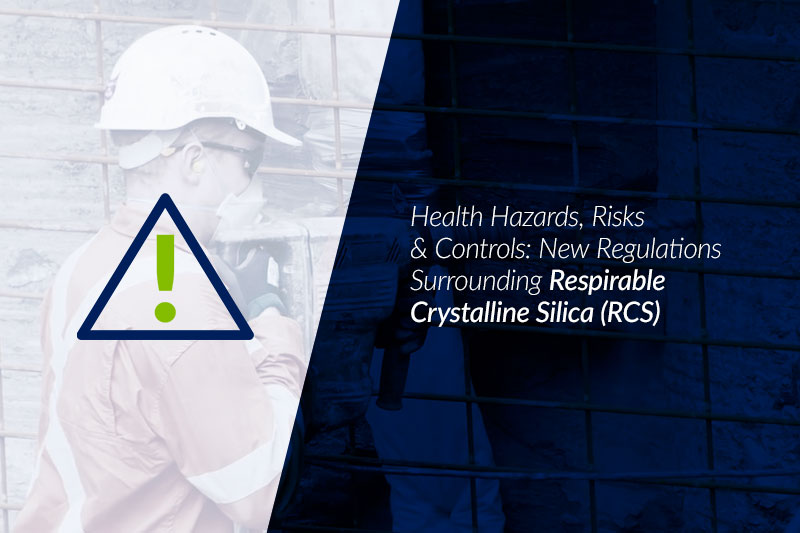News & Insights
Health hazards, risks and controls: New regulations surrounding Respirable Crystalline Silica (RCS)
New Respirable Crystalline Silica (RCS) regulations have come into force in Victoria in May 2022. This will have an impact on the construction and earth resources industries, as well as the tunneling, quarrying and engineered stone manufacturing sectors.
These changes mean the Person in Control of a Business or Undertaking (PCBU) will need to review their processes to identify if their workers are engaged in high-risk silica works. If so, a crystalline silica hazard control statement (CSHCS) will need to be prepared, which will outline the requirements for worker training and control measures to be implemented to work safely.
A ‘high-risk’ crystalline silica process is one in which activities are likely to result in an airborne concentration of RCS that exceeds half the exposure standard of 0.05 mg/m3, or that results in a risk to the health of a person in the workplace. If air samples are not available, consider the generally accepted principle that if there are visible emissions of concrete dust, the exposure standard is likely being exceeded.
Click here to download the Respirable Crystalline Silica Factsheet (PDF)
These new regulations apply to any activity involving:
- The use of a power tool or other forms of mechanical plant
- To cut, grind, polish or crush material containing crystalline silica, or
- Carry out any other activity involving material that contains crystalline silica that generates crystalline silica dust
- The use of a road header on an excavated face if the material in the face contains crystalline silica
- A process that exposes a person to crystalline silica dust arising from the manufacture or handling of material that contains crystalline silica
- A quarrying process involving material containing crystalline silica
- A tunnelling process involving material containing crystalline silica
- A process determined by the authority to be a crystalline silica process.
Although many of these activities are easily identified as a crystalline silica process, other tasks generating dusts may fail to be recognised, such as:
- Demolition of structures, building and refurbishment
- Drilling
- Chasing
- Contamination processes (including rock crushing and milling mineral samples)
- Road works and earth works
- Sanding
- Scabbling, scarifying and scrapping
- Cleaning processes (e.g., sweeping)
Any activity where a high revolution, impact or crushing/breaking type activity is occurring, has a greater potential to release RCS dust into the atmosphere. This can have irreversible health consequences if the lungs are exposed during inhalation.
Risk assessment of RCS processes
These new regulations require that a risk assessment is completed to determine if the process is high risk, or that you nominate the activity as high risk and complete a CSHCS and enact appropriate controls.
Whilst some of the listed processes are carried out by industries that have a historic understanding of RCS risks and health risk assessments, these regulatory changes are likely to impact operators without existing RCS management plans.
It is a requirement that these risk assessments include an evaluation of:
- The specific tasks or processes required to be undertaken with material containing crystalline silica
- The form of crystalline silica to be used
- The proportion of crystalline silica contained in the material
- Previous atmospheric monitoring results
- The likely frequency and duration of exposure to crystalline silica dust
- Any information about incidents, illnesses or diseases associated with exposure to crystalline silica in the workplace.
What materials contain crystalline silica?
Silica is one of the most abundant minerals found in the earth’s crust and can be found in quartz, stone, sand, soil, granite, bricks, cement, grout, mortar, bitumen and engineered stone products.
It is the crystalline form of silica in these materials that has raised concern in recent years. Materials such as drywall, fibre cement products, some paints, roofing tiles, pavers and stone such as granite, quartzite, sandstone, shale and limestones also have the potential to contain the crystalline form of silica.
Silica composition of various rocks and rock products
|
Type |
Silica Content |
|
Granite |
25-45% |
|
Shale |
22% |
|
Natural sandstone |
67% |
|
Composite (engineered or manufactured stone) |
>90% |
|
Aggregates, mortar and concrete |
Varies based on sand and mixture additions |
Source: SafeWork Australia
Manufacturers or suppliers of products that contain crystalline silica
From 15th May, 2022, if you manufacture or supply products containing crystalline silica, you must provide detailed information in writing to any person supplied with the product, and upon request, any employer who proposes to use the product.
This information must detail:
- The proportion of crystalline silica in the substance, expressed as a percentage
- The name, address and telephone number of the manufacturer (in Australia) or the importing supplier (in Australia)
- Any exposure controls, exposure standards, engineering controls and personal protection information in relation to the crystalline silica substance, and
- Information relating to the handling and storage of the crystalline silica substance including how it may be safely used.
This information will need to be reviewed and updated at least every five years, or as often as needed, and the updated information provided to supplied parties following the revisions.
Health Effects
Exposure to crystalline silica can lead to irreversible health effects and death from both acute (short-term) and chronic (longer-term) exposures.
Acute silicosis can develop quickly after heavy exposure to crystalline silica. The lungs fill with a protein containing fluid which causes severe shortness of breath and can lead to death.
Accelerated silicosis is associated with high exposure, where there is a rapid increase of scarring of the lung (fibrosis) within the first 10 years of exposure.
Chronic, or more typical, silicosis, where fibrosis occurs, happens more slowly, and can take up to 30 years to develop after the first exposure.
Silicosis affects the immune system and increases the potential for lung diseases such as tuberculosis.
Treatment options for individuals in advanced stages is palliative, unless a lung transplant is an option.
Controls
From 15th May 2022, an employer or a self-employed person must not perform high-risk crystalline silica work unless a crystalline silica hazard control statement (CSHCS) is prepared before the commencement of work and once undertaken is performed using the controls detailed in the CSHCS.
Australia-wide, occupational safety and health legislation requires employers, in consultation with workers, to identify hazards, assess risks and implement practical controls to protect workers’ health and safety.
A Certified Occupational Hygienist (COH®) can develop an exposure assessment strategy and assist in implementing regulatory requirements for occupational health and hygiene. Any occupational exposure assessment should start with a workplace characterisation process where workers are organised into similar exposure groups based on work activities.
An occupational hygiene program for crystalline silica should have a formalised communication process as well as an appropriate and regulatory compliant system of record retention.
Examples of controls for crystalline silica include:
- Choosing materials (e.g., abrasive blasting agents) that are silica free or have the lowest silica content
- Designing buildings with recesses for services to reduce the amount of chasing required
- Providing vehilces with enclosed cabs fitted with high effieicncy air filters, for dusty earthworks or mining
- Using wet work methods to reduce dust (e.g., wet cutting or polishing, water sprays during earthworks)
- Using water spray or rubber curtains around conveyor transfer points
- Using local extraction ventilation, either fixed or on-tool (e.g., for mixing, crushing, milling, drilling or chasing)
- Shadow vacuuming (e.g., during drilling)
- Vacuum clean-up rather than sweeping
- Not blowing dust with compressed air
In addition to other controls, personal protective equipment (PPE) such as an appropriate respirator (selected in accordance with Australian/New Zealand Standard AS/NZS 1715: Selection use and maintenance of respiratory protective equipment) may be required, depending on the task and the effectiveness of the other controls.
Hazard identification
Where hazards may be uncertain or complex to assess, Greencap's experienced occupational hygiene team undertake the identification of crystalline silica hazards through a five-step process:
- Basic characterisation
- Workplace information gathering
- Exposure assessment
- Hazard control
- Reassessments
Further reading
- High risk crystalline silica work and duties of manufacturers and suppliers commence on 15 May 2022 - WorkSafe
- Occupational Health and Safety Amendment (Crystalline Silica) Regulations 2021 (legislation.vic.gov.au)
- Occupational Health and Safety Regulations 2017 (legislation.vic.gov.au)
How Greencap can help
Risk-Based Hygiene Management Plans
Within Greencap's consulting team are a number of certified occupational hygienists (COH ®) and full members of the Australian Institute of Occupational Hygienists (AIOH) who assist clients with the development of risk-based hygiene management plans and review of their existing plans to ensure they are adequate to manage the hazards identified.
Workplace Monitoring
Greencap can conduct risk assessments, and develop and conduct workplace personal exposure monitoring for respirable crystalline silica and other workplace hazards.
Contact us using the form below for more information.



Greencap acknowledges the Traditional Owners of Country throughout Australia and recognises their continuing connection to land, waters and culture. We pay our respects to their Elders past, present and emerging.




